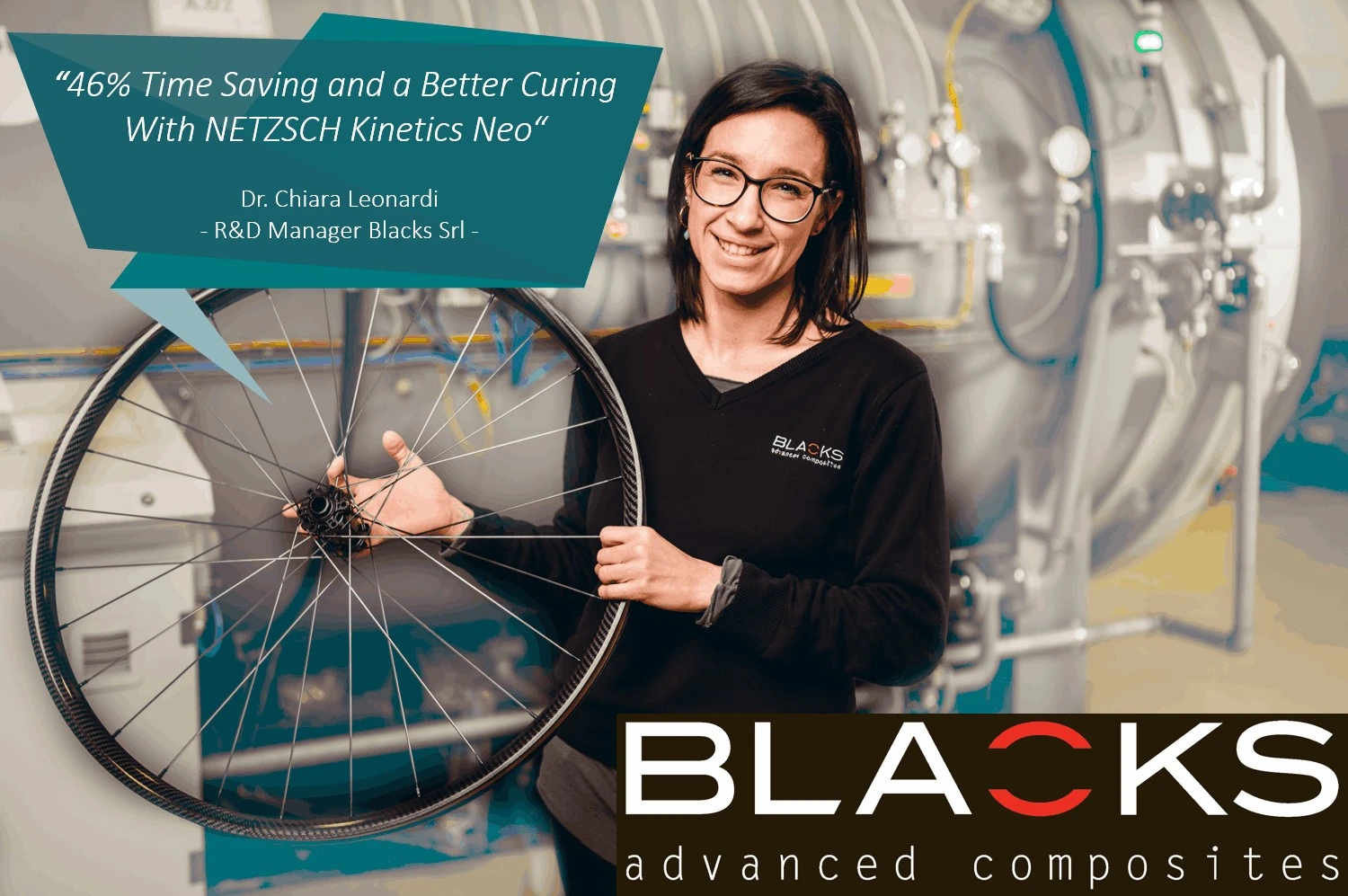
19.12.2022 by Dr. Chiara Baldini
60 Years of NETZSCH-Gerätebau: How to Optimize the Curing of Composites
As part of our year-long 60th anniversary celebration, which is focusing on software solutions in December, we would like to revisit a successful case study today. This article was made possible thanks to collaboration with Blacks S.r.l., an Italian company specialized in the design, prototyping and manufacture of advanced composite material components such as carbon, glass, aramid fibers and hybrid fabrics through hand lay-up and autoclave Curing (Crosslinking Reactions)Literally translated, the term “crosslinking“ means “cross networking”. In the chemical context, it is used for reactions in which molecules are linked together by introducing covalent bonds and forming three-dimensional networks.curing.
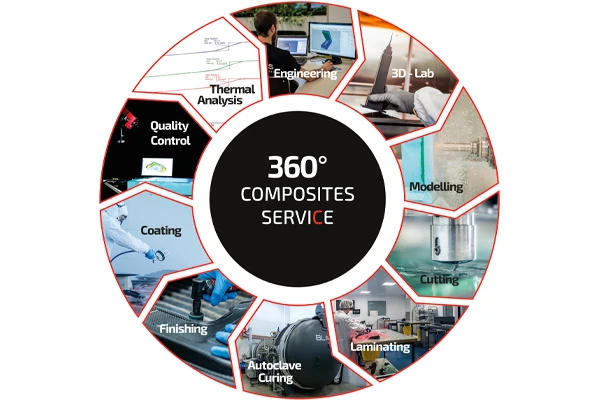
Kinetics Neo ‒ A Success Story:
In the following, we sum up the whole story together with Dr. Chiara Leonardi, R&D Manager at Blacks.
“Some years ago, we decided to expand our laboratory by purchasing both a DSC and a TGA from NETZSCH, in order to control both prepregs and cured products. Our daily need is to run routine measurements on incoming raw materials, the aging of prepregs, Glass Transition TemperatureThe glass transition is one of the most important properties of amorphous and semi-crystalline materials, e.g., inorganic glasses, amorphous metals, polymers, pharmaceuticals and food ingredients, etc., and describes the temperature region where the mechanical properties of the materials change from hard and brittle to more soft, deformable or rubbery.glass transitions, fiber content, and the cure degree of our final products, just to mention some examples,” says Dr. Leonardi.
In 2018, Blacks faced a new challenge: they were requested to produce a carbon bike rim. The targeted Curing (Crosslinking Reactions)Literally translated, the term “crosslinking“ means “cross networking”. In the chemical context, it is used for reactions in which molecules are linked together by introducing covalent bonds and forming three-dimensional networks.curing degree was set at 95%, to ensure both the mechanical and thermal performance levels requested by the customer. This value was defined after initial characterization of the selected prepreg performed by Blacks' thermal analysis laboratory.
When the production phase started, it was clear to Blacks that they needed to find a thermal cycle suited for achieving two main targets: reaching the Curing (Crosslinking Reactions)Literally translated, the term “crosslinking“ means “cross networking”. In the chemical context, it is used for reactions in which molecules are linked together by introducing covalent bonds and forming three-dimensional networks.curing target preset and shortening process times.
“Our approach is to apply, first of all, the Curing (Crosslinking Reactions)Literally translated, the term “crosslinking“ means “cross networking”. In the chemical context, it is used for reactions in which molecules are linked together by introducing covalent bonds and forming three-dimensional networks.curing cycle suggested in the technical data sheet of the prepreg. And this was the case for the autoclave consolidation of the first prototype rim, the ‘SN1’. However, this first production showed the need for post-Curing (Crosslinking Reactions)Literally translated, the term “crosslinking“ means “cross networking”. In the chemical context, it is used for reactions in which molecules are linked together by introducing covalent bonds and forming three-dimensional networks.curing to achieve the desired crosslinking level,” remembers Dr. Leonardi.
To qualify the achieved Degree of CureThe degree of curing describes the conversion achieved during crosslinking reactions (curing). degree of cure level, DSC measurements were performed using the DSC 214 Polyma on both the uncured resin (prepreg) to evaluate the total Curing (Crosslinking Reactions)Literally translated, the term “crosslinking“ means “cross networking”. In the chemical context, it is used for reactions in which molecules are linked together by introducing covalent bonds and forming three-dimensional networks.curing enthalpy of this material (Htot), and – under the same conditions – on an SN1 sample to measure the residual cure (Hres).
Figure 1 shows the DSC curves and the evaluated ExothermicA sample transition or a reaction is exothermic if heat is generated.exothermal Curing (Crosslinking Reactions)Literally translated, the term “crosslinking“ means “cross networking”. In the chemical context, it is used for reactions in which molecules are linked together by introducing covalent bonds and forming three-dimensional networks.curing signals for the two measurements.
The Degree of CureThe degree of curing describes the conversion achieved during crosslinking reactions (curing). degree of cure (α) was calculated with the following equation:

For SN1, the α value resulted to be 94.5%, hence lower than the targeted one.
How to reach the targeted Curing (Crosslinking Reactions)Literally translated, the term “crosslinking“ means “cross networking”. In the chemical context, it is used for reactions in which molecules are linked together by introducing covalent bonds and forming three-dimensional networks.curing degree?
In the absence of any other useful information, the classic method considers whether to either increase the maximum temperature or to extend the time of the IsothermalTests at controlled and constant temperature are called isothermal.isothermal segment.
This trial-and-error approach, however, is time consuming; it also requires long autoclave downtimes and has high raw material consumption. Moreover, it is not always exploitable: For instance, the maximum temperature choice is limited by the Decomposition reactionA decomposition reaction is a thermally induced reaction of a chemical compound forming solid and/or gaseous products. decomposition temperature of the resin itself.
That’s where NETZSCH know-how came into play.
“We decided to produce a second prototype rim by applying a Curing (Crosslinking Reactions)Literally translated, the term “crosslinking“ means “cross networking”. In the chemical context, it is used for reactions in which molecules are linked together by introducing covalent bonds and forming three-dimensional networks.curing cycle similar to the first one, but with a prolonged stasis. Though this cycle hit the targeted curing degree, the resulting total cycle time, 8 hours, was too long for our production capabilities,” continues Dr. Leonardi. “Therefore, we asked NETZSCH to help us find a new and faster thermal profile. We performed some new DSC measurements on the prepreg and we passed the data to NETZSCH, who did magic with its Kinetics Neo software.”
To perform kinetic studies, at least three different heating ramps or three different IsothermalTests at controlled and constant temperature are called isothermal.isothermal temperatures are normally mandatory for a complete thermal analysis measurement.
In this case, Blacks decided to apply dynamic ramps at rates of 1, 2, 5 and 10 K/min. The resulting evaluated thermograms are depicted in Figure 2.
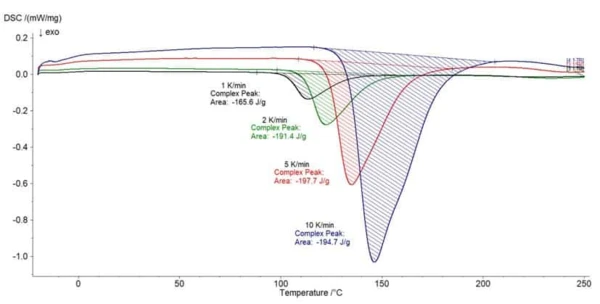
Performing kinetic studies and predicting the material behavior
To predict the curing behavior for different process scenarios, the DSC data measured at the four different heating ramps were uploaded into the NETZSCH Kinetics Neo software – which at the time had just been newly developed.
Figure 3 shows the conversion fit as a result of applying the model-free approach, chosen from among those available in the software: This is a new mathematic technique called “Numerical Optimization”, designed by NETZSCH to support users without experience in kinetic simulation and in industry in general, where time-consuming evaluations are often not compatible with production needs.
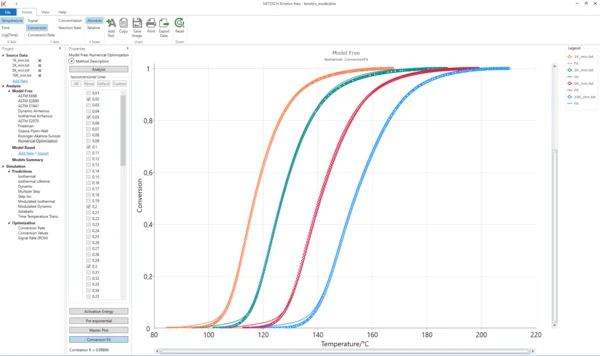
Moreover, in order to avoid overheating and hence material damage, the maximum reaction rate was limited in the software, to ensure that its value never exceeded the one measured for the curing cycle used to produce the SN2 prototype.
The total time for the newly designed curing cycle turned out to be 260 minutes; compared to the 480 minutes of the previous one, this sounded really promising for time savings in production.
But what about the targeted curing degree?
Shorter time, better curing efficiency
Blacks relied on the new optimized curing cycle and decided to apply it to manufacture a third prototype (SN3).
“When we tested the curing degree by DSC, the same way we did for the previous two bike rims, we realized that the kinetics-optimized curing cycle not only allowed us to almost halve the production time, but also to further improve the curing degree. A real happy ending,” concludes Dr. Leonardi.
Indeed, the autoclave manufacturing cycle of the CFRP bike rim by Blacks S.r.l. was reduced by 46% in time as compared to the previous cycle which had achieved the desired curing target; furthermore, it even exceeded the targeted Degree of CureThe degree of curing describes the conversion achieved during crosslinking reactions (curing). degree of cure (with a final result of 96.1%) and avoided overheating at the same time.
Figure 4 shows the comparison of all relevant data for the production of each bike rim at a glance.
This case study clearly demonstrated how production cycles can be optimized with a combined DSC-Kinetics approach. Compared to trial-and-error manufacturing, material characterization and simulation is much more efficient and requires just a few milligrams of resin, thus bringing big cost savings to the composite industry in terms of both raw materials and production time.
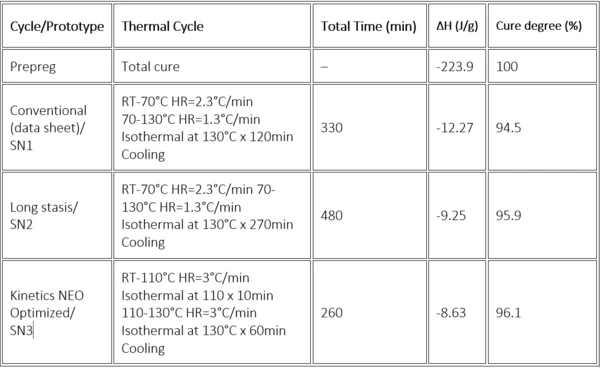
Acknowledgments
The collaboration between Blacks S.r.l. and NETZSCH extended to other areas and is still active. Dr. Chiara Leonardi has often been our guest speaker at conferences, seminars and webinars.
The “Curing Optimization” case study was also presented worldwide and published in Compositi Magazine (December Issue, 2018: pages 20-28). Here, you can read the full article for deeper insights into this project.
Furthermore, Blacks is continuously growing: the fifth edition of the “Champions of Growth” survey by the German ITQF Quality Institute acknowledged Blacks as among the 800 companies that drove the economic recovery this year, with an average annual growth rate of over 11.3% in the three-year period from 2018 to 2021.
This recognition reaffirmed their continuing commitment to the pursuit of excellence and innovation. It really seems that Blacks shares our Proven Excellence vision!
We congratulate our customer and once again thank Dr. Chiara Leonardi for the support, while looking forward to facing new challenges together.
______________________________________________________________________________________
For more information about how to use our Kinetics Neo software to model the curing process, please visit the dedicated website section.
If you are interested in viewing the recorded webinar presented by Dr. Chiara Leonardi, please contact our Italian branch office directly via email: info.niv@NETZSCH.com
